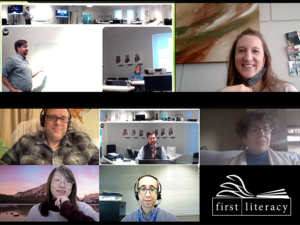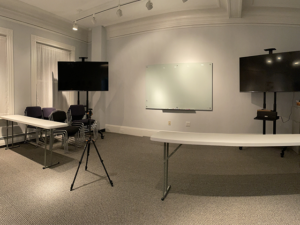Why Your Students Deserve a Hybrid Classroom and How to Deliver
Written by Bryan McCormick, First Literacy Program Director
 Students have paid a high price during the pandemic. A struggle for some is existential for others. As Omicron eventually fades, we will get to decide what the new normal looks like in educating our students.
Students have paid a high price during the pandemic. A struggle for some is existential for others. As Omicron eventually fades, we will get to decide what the new normal looks like in educating our students.
Should we expect students to continue to always be physically present in classes and not consider what that effort is costing them in money, time, and emotional health?
In the field of Adult Basic Education (ABE), adult students are facing many obstacles ranging from working multiple jobs to make ends meet, the wild west of finding high quality, affordable childcare, struggling to manage and pay for the new technology needed to attend school, and the high cost of transportation. Yet the adult learners that First Literacy supports are still bound and determined to further their education, despite the challenges exacerbated by the pandemic.
Leveling The Playing Field During A Pandemic
At First Literacy we are always thinking about how we can do more for adult learners and adult educators. How can we find a way to level the playing field and help ABE teachers continue to provide adult learners with a high-quality education in the midst of a pandemic? How can we meet teachers where they are at by allowing them to decide how they would like to participate in First Literacy professional development workshops?
Our virtual system can often take so much away from a remote presence, but with a high-quality hybrid classroom infrastructure it’s possible to give workshop participants an exceptional learning experience whether they choose to learn remotely or in-person.
A hybrid classroom includes technical infrastructure that allows for equal access to high-quality instruction and interaction for both in-person and remote participants.
Creating A Hybrid Classroom
The first step we took in creating our hybrid classroom was determining what technology we needed to create a hybrid space. To do this, we took time to consider what the experience is like when you choose to be physically present in a learning space. To start we thought about some of the senses we use while learning. (Note: we are not leaving out students with different physical abilities intentionally. We owe all of our students a space that fits their needs. This blog post is meant to be a helpful starting point when designing a hybrid classroom. We leave it up to you to adjust your hybrid space to make it work for all of your students.)
- Vision: When we’re watching an instructor in person, the instructor is typically not static, and we naturally turn our heads about as the instructor moves around. We are also not usually 12 inches from the instructor’s face staring at them as they sit stationary for 3 hours. We are used to seeing a person in context of their voice, tone, and body language.
- Hearing: When we’re in-person listening to an instructor, their voice has a natural, direct quality to it. When the instructor moves around our ears track the instructor providing a natural sound of the instructor’s voice.
Next, we broke down the problems we’re trying to solve.
- Vision: How do we break out of the talking head format and allow remote students to experience the instructor and other classmates in a more natural way? How can peripheral views, body context and natural movement be part of the experience for a remote student?
- Hearing: How can a learning experience be created for remote students that allows them to hear a more authentic tone and range to other voices in the class?
Once the problems were identified, we then attempted to create a modular system for our professional development workshops that could adapt to foreseen and unforeseen changes and challenges. Thanks to our funding partners at Untapped Resources we were able to purchase all the technology needed to make our new hybrid space a reality. Much of our hybrid classroom set up mirror’s what could be done in a standard hybrid classroom with a group of adult learners.
Say Goodbye To The Talking Head
As we laid out the plans for our new hybrid classroom, we were committed to putting an end to the talking head for our remote workshop participants. Rather than watching an instructor from 12 inches away, we wanted to create a virtual classroom with a wider view allowing more natural movement and body context. This wider view would also provide a more natural teaching space for instructors to present.
 The first step in creating this larger space was looking at wider angle cameras that had auto tracking and zoom features. We wanted to give instructors the space to sit in front of a computer managing slides, walk around the room during a lecture, write on the dry erase board, project an image, or use a document camera. Most of this is impossible to do with fidelity over a laptop webcam.
The first step in creating this larger space was looking at wider angle cameras that had auto tracking and zoom features. We wanted to give instructors the space to sit in front of a computer managing slides, walk around the room during a lecture, write on the dry erase board, project an image, or use a document camera. Most of this is impossible to do with fidelity over a laptop webcam.
We also considered how the instructor and in-person participants see remote participants. We wanted to give instructors and in-person participants their own individual views on small screens and create a shared view of the class that boosted the feeling of community.
To achieve this, we plan to provide every in-person workshop participant with access to a laptop or Chromebook. Two large monitors were also installed on mobile carts in our hybrid classroom to provide flexibility and create a shared viewing experience between the instructor and in-person participants. We also wanted our hybrid classroom to give teachers an opportunity to write and create visuals for participants using the dry erase board . This also follows best practices in education by providing different types of learning styles.
Lastly, we decided that the most important piece for our hybrid classroom was to make sure the presenter had a simple way to share what they had written or drew on the dry erase board with both remote and in-person participants. After much research we decided to go with a specific white board camera. This type of camera does not have all the functionality of smart boards, but it is less expensive and much easier to use The white board camera does a really nice job of projecting what’s on the board onto the remote participants screens. The white board camera we chose also records everything that is written on the board during a lesson and can be downloaded by teachers and participants.
Time For The Mic Drop
Relying on inadequate laptop microphones to present voices to remote students is an ongoing challenge in a virtual setting. Our new hybrid classroom gives participants access to better sound and range.
While microphones and blue tooth clip on mics work well these devices can contribute to an unnatural flow to teaching and learning as they need to be passed around to various talkers. Clip on blue tooth mics also welcome a host of other issues including forgetting to unclip the device before using the bathroom (yes there is a story there).
Our new hybrid classroom will take advantage of self-tracking and multi-dimensional microphones that are built into the camera’s operating system and structure. This not only makes our system simpler but will lead to more authentic connections between those attending class in-person and remotely.
Learning Environment Matters
Every teacher knows that space matters. Our learning space at First Literacy is an integral part of the high-quality professional development workshops that are key to the success of adult learners. First Literacy workshop participants deserve an appropriate learning space and it’s our job to deliver. We know the barriers for our ABE school partners can be great. Space, money, and time are all precious commodities that are always in short supply – especially in the world of Adult Basic Education.
Our adult learners also face mountains of obstacles that can shade their goals. Adult Basic Education organizations and schools have already done the hard work of creating a physical classroom space. They may not be an ideal shape, size or in the “right” location but that hard work has been done. The next steps are to steal the lessons we’ve learned from this pandemic and give students flexible options that allow them to decide whether they want to learn in person or remotely, and make sure they have the right infrastructure to be successful.
How is your organization managing the challenges and opportunities of remote learning? How are the adult learners in your classes coping with pivoting to technology like Zoom and Google Classroom?
For more information about the upcoming launch of First Literacy’s hybrid classroom contact Bryan McCormick at bmccormick@firstliteracy.org. To learn more about the technology First Literacy is using to create a hybrid learning space download our hardware list.
